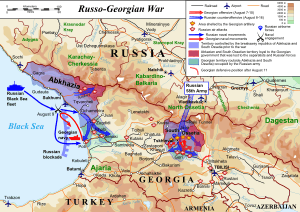2008 South Ossetia war facts for kids
Quick facts for kids 2008 South Ossetia war |
|||||||||
|---|---|---|---|---|---|---|---|---|---|
| Part of Georgian–Ossetian conflict and Georgian–Abkhazian conflict |
|||||||||
 Location of Georgia (including Abkhazia and South Ossetia) and the Russian part of North Caucasus |
|||||||||
|
|||||||||
| Belligerents | |||||||||
| Commanders and leaders | |||||||||
|
|
|||||||||
| Strength | |||||||||
|
|
10,000 soldiers. In Abkhazia: 9,000 soldiers. |
||||||||
| Casualties and losses | |||||||||
|
11 killed, 3 missing, 227 wounded |
|
||||||||
|
Civilian casualties: |
|||||||||
The 2008 South Ossetia War was a short but intense military conflict. It took place in August 2008 between Georgia on one side, and Russia along with forces from South Ossetia and Abkhazia on the other. This war was part of ongoing disagreements in the region.
South Ossetia and Abkhazia are areas within Georgia. They declared themselves independent in the early 1990s. However, most countries around the world, including the United Nations members, do not officially recognize them as independent states. They act like independent countries, but their status is disputed.
Contents
Understanding the Conflict
What Caused the War?
The conflict began on August 7, 2008. Georgia stated that South Ossetian separatists had broken a ceasefire, which is an agreement to stop fighting. Georgia claimed these separatists attacked villages. South Ossetian officials, however, denied these attacks.
Following these events, Georgia launched a military operation. Their goal was to surround and take control of Tskhinvali, the capital of South Ossetia.
Who Was Involved?
The main sides in the conflict were:
- Georgia
- Russia, supporting South Ossetia and Abkhazia
- Forces from South Ossetia
- Forces from Abkhazia
Russian military troops joined the war to support South Ossetia. They played a key role in the conflict's outcome.
How the War Ended
The war officially ended on Saturday, August 16, 2008. Russia, South Ossetia, and Abkhazia achieved victory. As a result, Georgia lost control over parts of Abkhazia and South Ossetia that it had previously held.
After the war, Russia and Nicaragua officially recognized South Ossetia and Abkhazia as independent countries. Most other nations did not follow this recognition.
The conflict also led to many people being displaced from their homes. This included ethnic Georgians leaving South Ossetia and the Kodori Gorge.
Aftermath and Impact
After the fighting stopped, Georgia took its case to the International Court of Justice. This court helps countries resolve legal disputes. The case was known as "Georgia versus Russia (Hague court application, 2008)".
The war had a lasting impact on the region. It changed the political map and the lives of many people living there.
Images for kids
-
Fragment of the 1856 map by J. H. Colton, showing the territory of modern South Ossetia within Georgia and Imeria. Modern North Ossetia corresponds to "Ossia" (Ossetia) in the North Caucasus. Ossetia became part of the Mountain ASSR in 1921 and was renamed into North Ossetia only in 1924.
-
U.S. President George W. Bush and Georgian President Mikheil Saakashvili in Tbilisi, May 2005
-
Russian President Vladimir Putin at the 2008 Bucharest Summit
-
Russian guided-missile ship 12341 Mirazh (Mirage) in Sevastopol
-
Joint press conference by Russian president Dmitry Medvedev and French President Nicolas Sarkozy after negotiations on the plan
-
Sergey Bagapsh (left), Dmitry Medvedev (middle) and Eduard Kokoity (right) shortly after the recognition of Abkhazia and South Ossetia
-
US Secretary of State Condoleezza Rice and President of Georgia Mikheil Saakashvili at a Tbilisi press conference, August 2008
-
Russian Tu-22M3
See also
 In Spanish: Guerra ruso-georgiana para niños
In Spanish: Guerra ruso-georgiana para niños



















